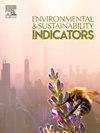Population dynamics, economic growth, energy mix, and environmental pollution in ASEAN: Exploring the role of renewable, nuclear, and nonrenewable energy using the CCEMG approach
IF 5.4
Q1 ENVIRONMENTAL SCIENCES
引用次数: 0
Abstract
This study uses a stochastic impact model based on population, wealth, and technology to examine carbon dioxide (CO₂) emissions in the Association of Southeast Asian Nations (ASEAN) region from 1990 to 2021. To investigate the long-term and short-term interactions between energy and the environment, this study applies the Common Correlated Effects Mean Group (CCEMG) methodology as the baseline regression. The Stochastic Impacts by Regression on Population, Affluence, and Technology (STIRPAT) approach shows the complexities of the impacts of economic activities, development, technology, and population growth on environmental quality. The findings suggest that expanding renewable energy consumption and increasing the role of nuclear energy in electricity generation, are significant strategies for reducing CO₂ in ASEAN countries. The CCEMG findings suggest that CO₂ emissions are negatively correlated to the use of fossil fuels. The Fully Modified Ordinary Least Square and Dynamic Ordinary Least Square tests demonstrated that CO2 emissions decreased with more use of renewable and nuclear energy sources. However, economic growth, population expansion, and increasing energy intensity have significantly contributed to the persistent rise of CO₂ emissions across the region. This research highlights the necessity of diversifying the energy mix, improving energy efficiency, and redesigning economic and demographic development paths to enhance environmental standards in ASEAN.
求助全文
约1分钟内获得全文
求助全文
来源期刊

Environmental and Sustainability Indicators
Environmental Science-Environmental Science (miscellaneous)
CiteScore
7.80
自引率
2.30%
发文量
49
审稿时长
57 days
 求助内容:
求助内容: 应助结果提醒方式:
应助结果提醒方式:


